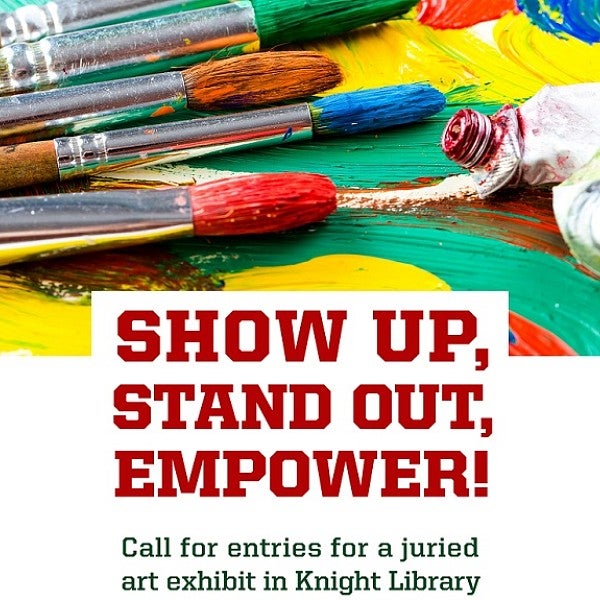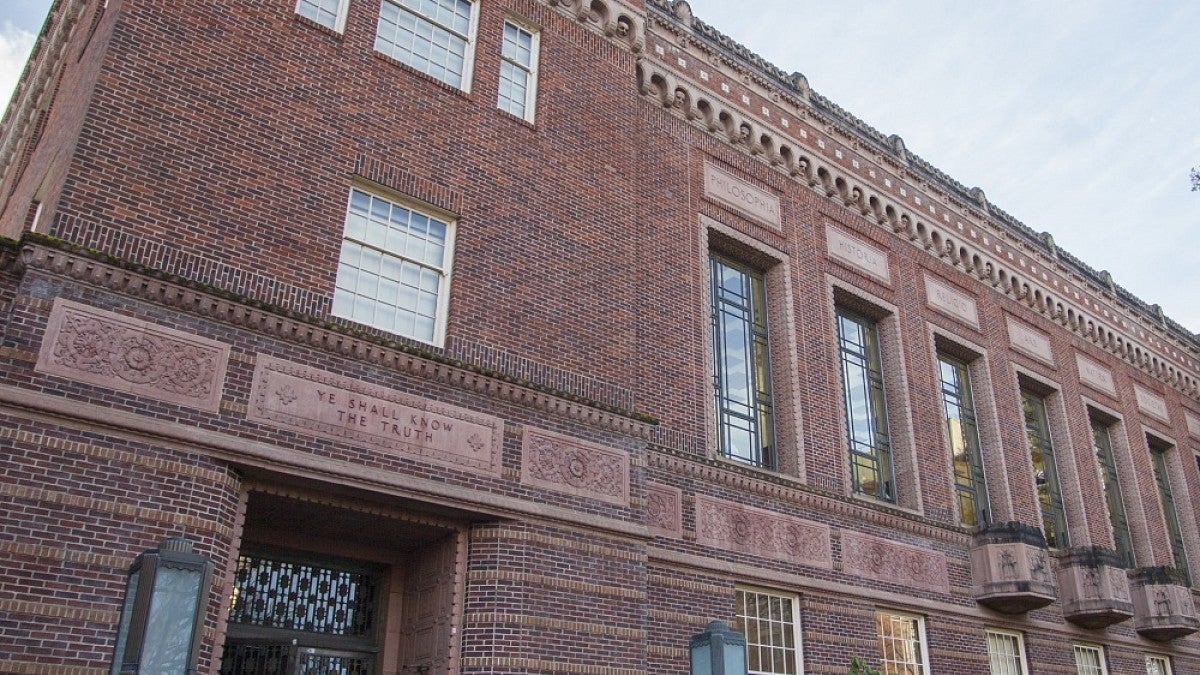As certain historic murals on display in the library continue to inspire a spirited and at times contentious campus discussion, the Knight Library Public Art Task Force has announced an open call for student work to be included in a juried exhibition of art that will better express the values of the campus today.
“We are moving forward with plans to mount a display of contemporary creative works responding to the content of the controversial panels,” said Adriene Lim, dean of libraries and Philip H. Knight Chair. “Our aim is to showcase creative expressions promoting the culture that students of today aspire to have.”
The theme of the exhibition will be “Show Up, Stand Out, Empower!” The art will be displayed in a variety of Knight Library spaces from Oct. 15 to March 15. The deadline to submit work for consideration is Aug. 10.
“The process we’ve designed in the libraries is about contextualizing the art, not removing it,” Lim said, while acknowledging that the issues involved were highly complex. “As a woman of color and former activist myself, I fully understand why the work is offensive for many members of our community. But I also believe that this art can be useful for us in terms of motivating us to engage in much needed dialogue about intellectual freedom, cultural memory, historic preservation and social justice."

The task force is comprised of librarians, faculty members, campus partners and students. During the first phase of the project, the group created Historic Knight Library: Art and Architecture, a comprehensive guide to the building, the art that adorns it, the people who made it and the historical contexts in which the various works were created.
Among the artworks described in the library guide are those that have inspired the protest activities.
Painted in 1937 by Nowland B. Zane, the mural that has caused the most offense is one of two panels depicting text inscriptions. As conceived, they were intended to be "reminiscent of medieval missal manuscripts.” Like the Knight library building itself, the mural was commissioned and funded through the Depression-era Works Progress Administration federal employment program.
Prominently exhibited in Knight Library’s west stairwell, “The Mission of a University” enshrines a text written by Frederick G. Young, former dean of Oregon's School of Sociology and a founding member of the Oregon Historical Society in Portland. Painted on canvas and affixed to a niche in the wall, the text states, in part:
“From now on it must be a climb if our nation is to hold its position among the nations of the Earth. It means conservation and betterment not merely of our national resources but also of our racial heritage and of opportunity to the lowliest.”
First-year student Francesca Smith is among those who petitioned the UO to take down the “Mission of a University” mural. In November 2017, she posted a petition at change.org entitled “Let's get this racist mural in a federally-funded university library removed! #TearItDown.” More than 1,750 signatures have been collected to date.
In the petition, Smith said she and a number of her concerned peers found the mural to be “extremely offensive and degrading to students of color, denigrating our very existence on this campus.”
Smith argued that the work was not only offensive but that it also exerted a deleterious effect on the education process.
“Upon reading this mural, I immediately felt unwelcome and disconnected from a sense of fellowship and safety in the space meant for learning,” she wrote.
At the invitation of the dean of libraries, Smith is serving on the Knight Library Public Art Task Force, representing concerned students.
Although the “Mission” panel has generated the majority of protests, a pair of figurative murals, “Development of the Arts” and “Development of the Sciences,” have on some occasions also been accused of reflecting white supremacy.
These panels were created by artist-brothers Arthur and Albert Runquist, UO graduates whose works are displayed in museums throughout the Pacific Northwest. While the Runquist brothers were regarded as politically progressive artists in their own time, activists of today have raised serious issues concerning the dynamics of gender, race and privilege depicted in these library murals.
Addressing the library murals and the controversies surrounding them, Laura Pulido, professor and head of the Department of Ethnic Studies, spoke at a Jan. 30 forum, “Public Art, Cultural Memory and Anti-Racism” held in the Knight Library Browsing Room.
“The only way to move forward, to not be held hostage to our past, is to engage the past,” Pulido said. “I understand that many want to tear down racist symbols of the past for reasons I respect. But I am opposed to such erasures. To dismantle the racist symbols of the past is to eradicate the evidence of a violent, white supremacist history. This is exactly what we don’t need.
“Please do not take this mural down. This mural is part of the great reckoning. You are part of the great reckoning,” Pulido said, referring to UO community members. “This mural is a powerful indictment of the past.”
Notably, the twin panel to Young’s “Mission of a University” statement, which hangs in the Knight library’s east stairwell, has remained uncontroversial. Also dating to 1937 and painted by Zane, “Opportunity for the Youth of Oregon” quotes Luella Clay Carson, the first chair of UO’s English department and namesake of Carson Hall.
In a lyrical counterpoint to Young’s entreaty for “racial heritage,” Carson offered words that now seem to echo through the ensuing decades, speaking directly to contemporary struggles:
“It is a responsibility to tear down errors of the past and to put in their places new ideals. It is a greater responsibility to hold fast to the truth of the past, undisturbed, in the complex, experimental present.”
In thinking about the challenging issues raised by the mural protests, the dean of libraries said Carson’s words seem relevant today.
“Racism, misogyny, white supremacy — these things are real,” Lim said. “In my life I have experienced them firsthand. However, I also believe that it would be a grave mistake to remove all evidence of this history from our highest cultural institutions, including libraries where censorship is against our most cherished values. I believe the most productive approach is responding to these particular works with our own creative expressions. This contextualization is the key to ensuring that future generations of scholars and activists will be fully informed.”
—By Jason Stone, University Communications


